The fight against the spread of misinformation is no easy task. To help stop the spread of misinformation, it is worthwhile to know who its creators are. In most instances, misinformation creators are and will remain unknown. However, the personality profile of the creators and spreaders is known and understood. There are seven personalities known to create misinformation and contribute to the global challenge of spreading misinformation:
- The Joker – This person spreads misinformation or creates it because they think it is funny. This person may be inclined to create and spread misinformation to get a reaction from their viewers or see if it goes “viral.”
- The Scammer – This is the person who creates misinformation for personal monetary gain. They play on other people’s fear and insecurities. Scammers get people to buy something, donate to a cause, or collect personal data for nefarious reasons.
- The Politician – Some well-known politicians have been caught creating and spreading misinformation. Many have spread misinformation for political gain, whether unintentional or intentional.
- The Conspiracy Theorist – This person insinuates connections between events even when no connection exists. They like to make people think that every event was intentionally set in motion. A common trait among conspirators is distrusting organizational institutions, including the government. They actively recruit people to believe their theories and help spread their misinformation.
- The Insider – This is the person who is considered an “expert” in a particular field or a source known to be trustworthy. This person will claim to have information gained from their work that has not been made public. Expert and trusted sources can be subjective to a reader. Understanding what qualifies a person to achieve such a title and learning how to spot those sources are key. Check out the CRAAP test to verify credible sources.
- The Relative – There is that relative in almost every family. This person desires to keep their family informed at all costs. They share information they believe to be true or share it because they feel it to be “interesting if true .” The relative to me embodies the definition of misinformation. They share information they believe to be true and do not always realize it started as disinformation.
- The Celebrity – This person typically has a large following on social media and uses those platforms to magnify certain causes. They share misinformation sometimes unknowingly or to remain relevant. Some celebrities have used their status and influence to do great things for social causes. However, some can do harm, especially when their followers hang on their every word.
Understanding these personality types that spread misinformation, whether intentionally or unintentionally, can help the unsuspecting public be skeptical when seeing questionable information. However, I worry that knowing the misinformation spreader’s personalities is not enough. We need to find ways to engage the public on how misinformation is created, provide them the tools to spot misinformation, and teach them how to confirm it as misinformation.
Using Misinformation to Fight Misinformation
Many experts in the technology field are developing tools to help the public resist the lure of misinformation. What I find most interesting is the language experts are using to combat the spread of misinformation. In a 2019 article posted on CNN.com, the author used terms like virus, vaccine, and inoculation, making this article even more relevant in today’s climate. The author compared the spread of misinformation to be like a virus, and one way to stop it is with a vaccine of sorts. The vaccine to prevent the spread of misinformation is prevention techniques, and inoculating people can make them immune to misinformation. Using these play on words is brilliant and relatable, making this idea easy to grasp.
Using the “inoculation theory” to combat the spread of misinformation was introduced around 2017. The idea behind this theory is to use misinformation against misinformation. The term inoculation was linked to vaccination back in the 15th Century and gained popularity in the 1790s during the smallpox epidemic. To inoculate means the act of taking a piece of one thing and implanting it to another to bring about something new. Since a live piece of the smallpox virus was injected into a healthy person to create immunity to the virus, physicians began using inoculation when referring to vaccination.
Misinformation is said to spread similarly to viruses. Using the inoculation theory to compare with immunizing people to misinformation is taking an idea and implanting it into a person’s mind. This definition may sound a bit extreme but think of it like this instead. The more exposed to minor forms of misinformation I am, and my mind knows to register it as misinformation, I develop an immune response and do not engage it or share it. Once I am inoculated, I am immune to future variants of misinformation because of my immune response to earlier forms of misinformation.
However, the people who create it continue to find clever ways to share it and get others to share it. Later in the CNN article, the author shares how some social media platforms are prime grounds for spreading misinformation. The misinformation creators use the group chat feature to engage unsuspecting users. Even with their creative tactics, technology companies are equally finding innovative solutions to prevent the misinformation virus, and they are taking it straight to the people.
A New Game in Town
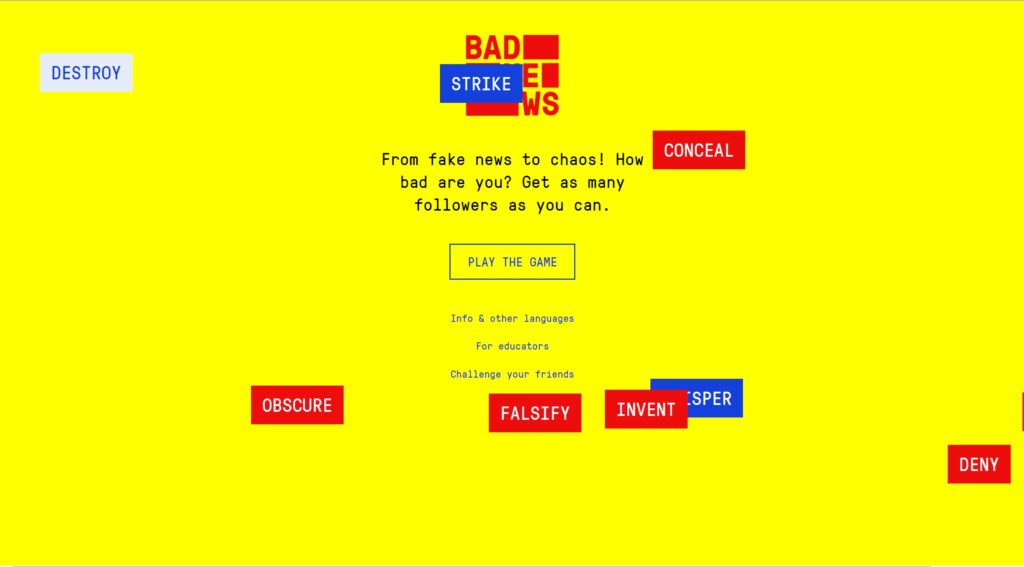
Technology companies have been trying to educate the public with conventional tactics seen in educational settings. The United Nations in 2020 launched the Pause Campaign urging people to “pause and #TakeCareBeforeYouShare” using social media to spread the word. This campaign is designed to get people to pledge their commitment to verify the information before sharing it on social media and sharing their commitment using the hashtag. By July 2021, the Pause Campaign has seen a global reach of one billion people.
Unfortunately, these approaches do not engage everyone on the same level. Two researchers of misinformation spread believe they may have found a tool that will engage people using psychological methods to learn. They developed a video game that lets people design “fake news,” and since people will know how it is made, they will not be “fooled” by it in the future. The Bad News Game touches on six known misinformation schemes:
- Impersonation
- Provocative or Emotional Content
- Polarization
- Conspiracy Theories
- Discrediting Opposition
- Trolling
Being intrigued at how misinformation spreads, I played the game.
I earned all six badges, and my fake news creation earned me almost 10,000 Twitter followers. I opted to create tweets that played on people’s emotions and utilized bots to generate buzz around the tweets. The more I used bots, my follower base grew. As my follower count grew, so did my credibility score.

It was eye-opening to see how easy it is to create misinformation and amplify it through social platforms. Playing the game has helped me better understand misinformation spread and will #TakeCareBeforeYouShare.
Confirmation That It Is Fake
I am a bit embarrassed to admit that I often use my “gut reaction” to evaluate something to be fake news or misinformation. I thought this to be a sound methodology in determining something’s fakeness. To my astonishment, people who use “gut feelings” are more likely to believe and affirm misinformation. The reason for this lies in the gut and brain connection. The “gut” possesses intuitive reactions, and the brain makes connections between past experiences to current information. This connection is known as the predictive processing framework, where analytical and intuitive thinking modes come together. Unfortunately, our natural processing is not without fault. These two thinking modes mostly work in unison but also independently.
Research has shown that intuitive thinking can cause cognitive bias since it quickly recalls past experiences or information. Since cognitive bias lives within the intuitive thinking mode, it makes sense that research concludes people who trust their gut over evidence fall prey to misinformation. Over 50% of people strongly agree they rely on their gut instinct when evaluating fake versus real information. Intuitive decision-making is not always considered harmful. The challenge with gut intuition is its connection to unconscious bias. People are encouraged to confirm their instincts by seeking credible evidence to support them.
There are additional tools available online that help people realize “gut instinct” may not be a perfect science. Buzz Feed News offers a quiz to test one’s naivety meter. A series of headlines are presented in the quiz to rate whether the headline is true or false. Being a “gut instinct” person myself, I took the quiz and realized the research was correct in my case. Out of seven headlines, I only answered three correctly. I earned a fake news detective badge with the encouragement to keep digging for the truth.
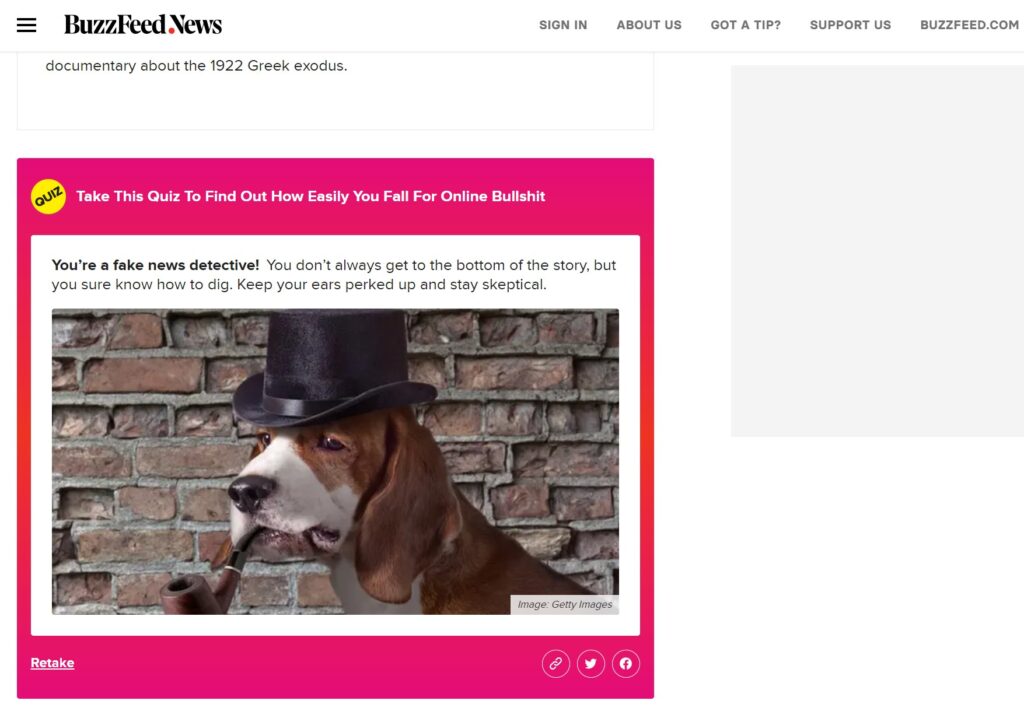
Puzzle Pieces Fit Together
The take-away from this information is that there are people out there with nefarious intentions who plant seeds of doubt through misinformation and how many people can be fooled. Prebunking interventions show promise in reducing people’s vulnerability to misinformation. Online games and quizzes are great tools to help people understand:
- How easy it is to create and disseminate misinformation
- Why misinformation is created
- The importance of being skeptical
Social campaigns like #Pause and #TakeCareBeforeYouShare help people understand how sharing misinformation harms public health and safety. These campaigns rally people to get involved and be part of a group committed to preventing misinformation.
Our “gut instinct” should not be discounted, but the importance and necessity to find credible evidence are vital. With the various learning tools available, we can become immune to misinformation. Immunity to misinformation can be our best tactic in fighting back against misinformation.
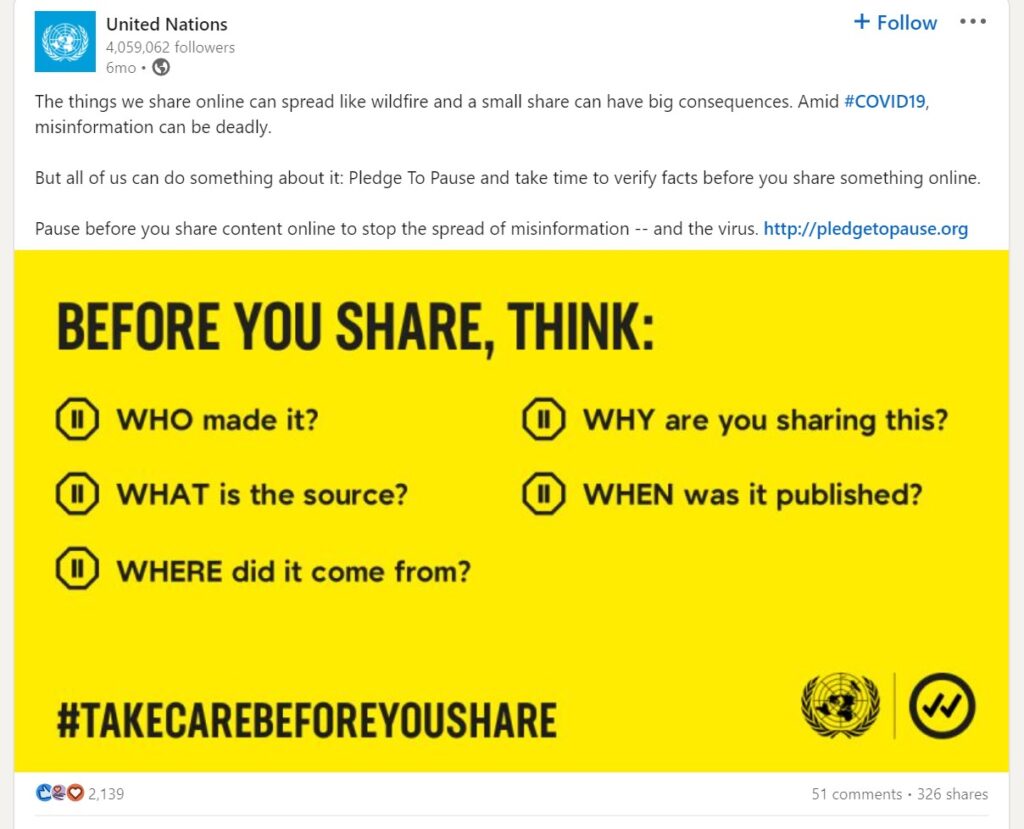


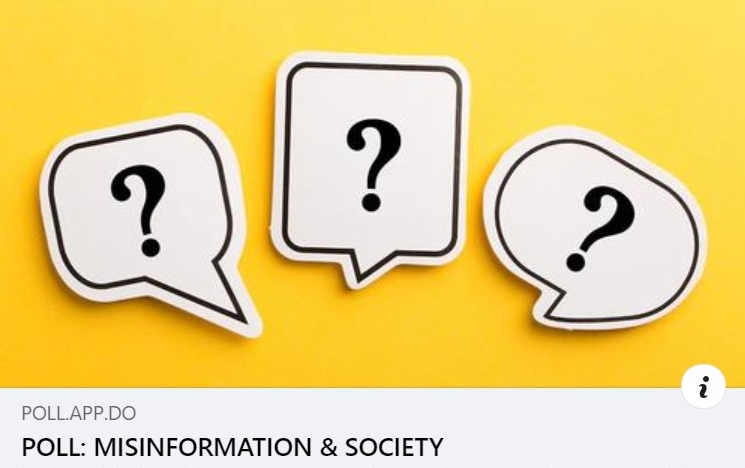
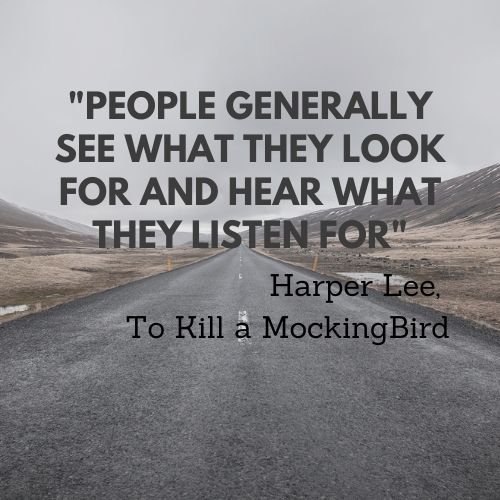
One thought on “The Fight Against Misinformation”